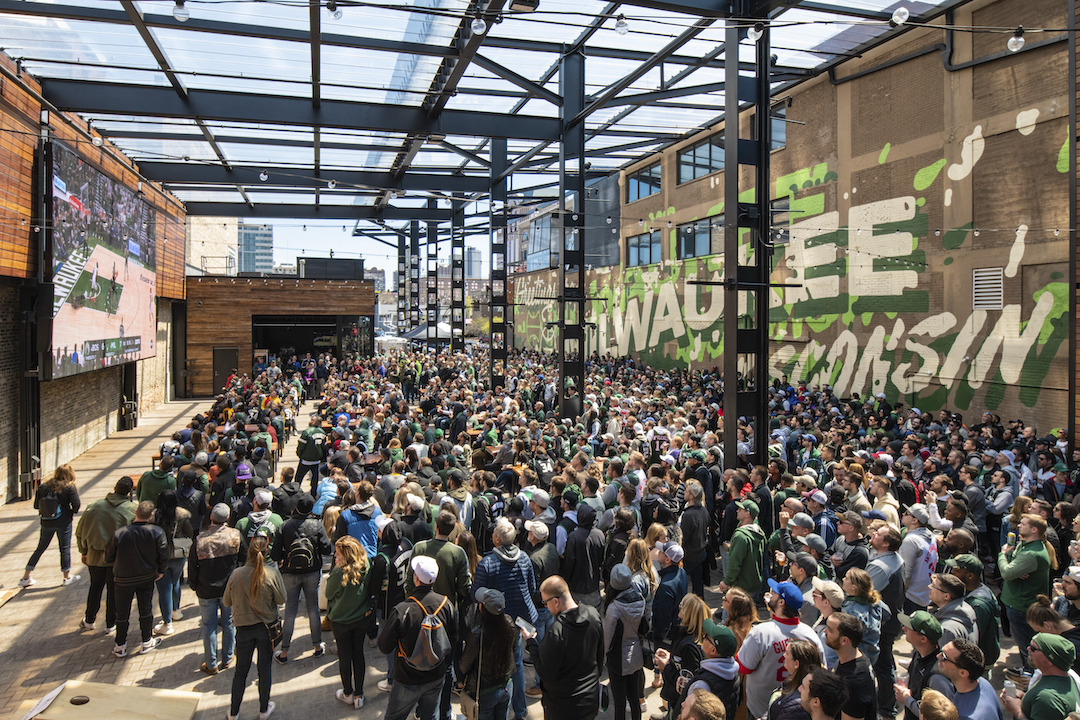Giannis Antetokounmpo has been the talk of the basketball world after leading the Milwaukee Bucks to their first NBA Championship in 50 years. After dropping 50 points in the clinching game six and winning Finals MVP, it’s been well deserved.
But hot on his heels for Finals MVP, and perhaps MVP of the entire playoffs was the Milwaukee Bucks Deer District, the sobriquet of the entertainment district built on the 30 acres that surrounds the Fiserv Forum. Tens of thousands of Bucks fans flocked to the Deer District for every home game during the team’s 2021 playoff run. This culminated with an estimated 65,000 fans who packed the area outside of the arena for the Game 6 victory, dwarfing the capacity crowd of just over 17,000 inside.
Designed by Gensler, the Deer District helped provide what was arguably the best home court advantage for any team throughout the playoffs. “I think seeing the crowds at the Deer District exceeded all our expectations,” said Aleksandar Sasha Zeljic, AIA, NCARB, LEED AP, Principal and Project Lead, Gensler. “We were thrilled to see the District in action and serving the purpose it was designed for, which is to bring fans together.”

© Richard Ebbers, Design by Gensler in partnership with RINKA
The architecture of the district is meant to be a modern interpretation of the industrial heritage of the city. Exposed steel and aluminum framing, glass, wood, and masonry materials are all incorporated into the space.
The district opened in tandem with Fiserv Forum in 2019 and acts as a catalyst for the development and an evolution for both itself and downtown Milwaukee, creating a year-round urban destination in the heart of the city.
Tech, tech, and more tech: Bringing fans together, inside and out
A main goal of the Deer District’s design was to elevate fans’ game day experiences, which it did for tens of thousands of fans who were unable to get tickets to games throughout the playoffs. The arena and the surrounding entertainment district creates a cohesive game day experience for all fans, whether inside the arena itself or outside in the Deer District. “Fiserv Forum, the plaza, and the larger entertainment district were fundamentally designed to support each other,” Zeljic said.
The design for the entertainment district and plaza where not even started until the design for the arena was almost completed. This allowed the designers to focus on ensuring these spaces felt connected despite being very different in terms of overall complexity.
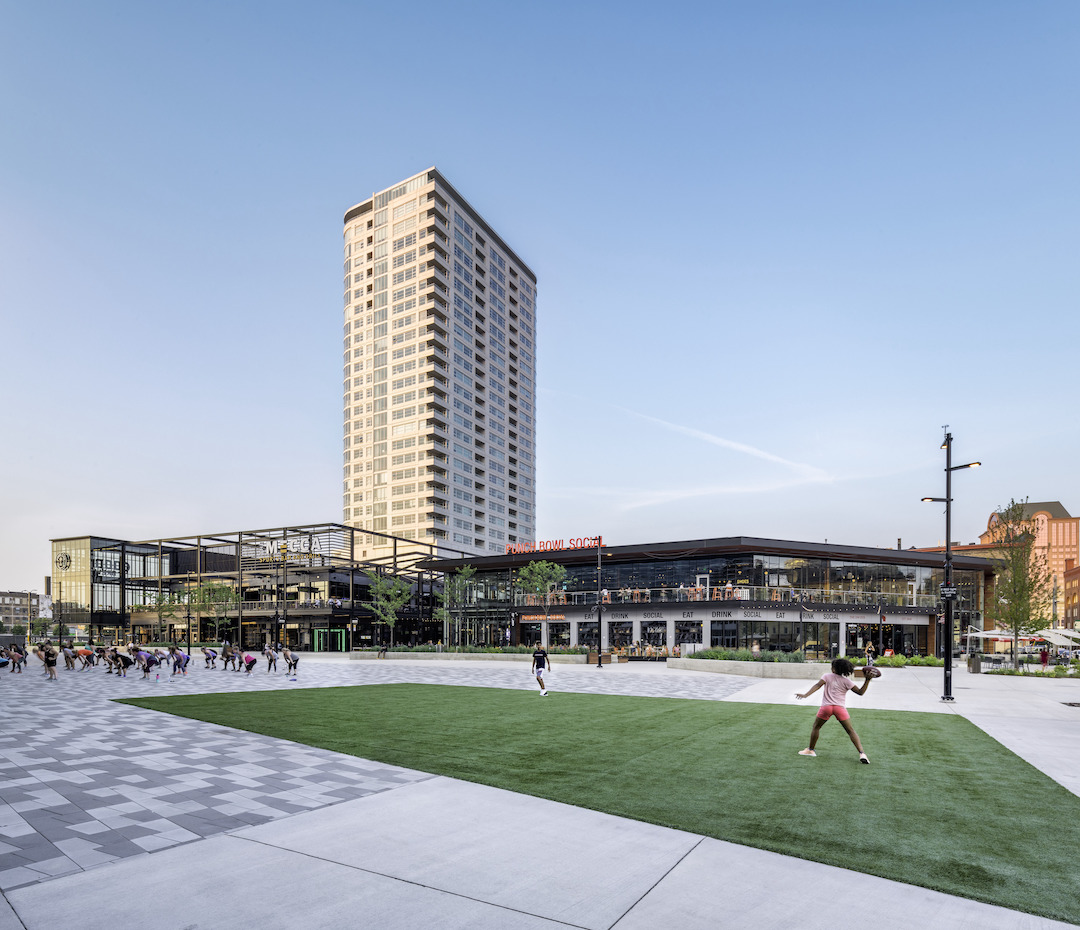
© Richard Ebbers, Design by Gensler in partnership with RINKA
A strategy that helped create a seamless connection between inside the Forum and outside in the District was the intentional use of technology. Or, as Ryan Sickman, Principal and Global Leader of Gensler’s Sports Practice, put it, it was all about “tech, tech, and more tech.” Broadcasting screens and other forms of real-time entertainment help to bring the experience and energy from inside the arena to the surrounding entertainment district.
“Even though we are an increasingly mobile-dependent society, we still like watching events together as a group,” Sickman said. “Watching a feed on your personal device that may be a second or two off from the mass group is generally not much fun, so providing a large enough display or a sufficient number of displays that will allow everyone to watch together in real time contributes to the togetherness and heightens the overall fan experience.”
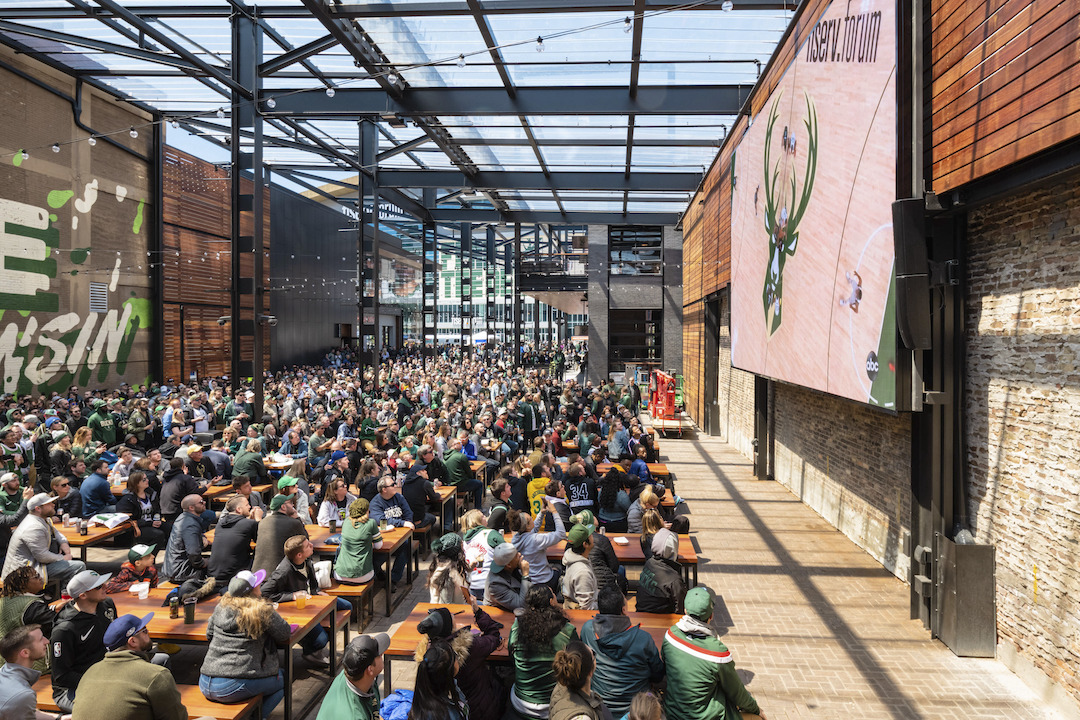
© Richard Ebbers, Design by Gensler in partnership with RINKA
Indoor-outdoor dining areas adjacent to the plaza and various levels of balconies promote activity both at ground level and above. The balconies work to turn the building into a public arena that frames the plaza with tiered views of the center of activity, which mimics the action inside Fiserv Forum and provides a similar arena experience.
“As we look to the future, simultaneously and ceremoniously connecting the design of the venues with their surrounding districts will be vital to creating connections between the inside and the outside of venues in a way that feels organic and intentional,” said Zeljic.
Numbers vs Human Experiences
Big crowds can be exciting and newsworthy, but a successful entertainment district isn’t all just a numbers game. Human experiences need to be at the forefront of the design. After all, only a few teams a year make a deep playoff run that brings extra amped up fans on game days.
Successful entertainment districts need to be able to survive and remain active when a team is winning, but also when a team is losing. Non-playoff bound teams in the NBA play 41 home games a season. NFL teams are only guaranteed eight home games a season. For the rest of the year, a stadium’s entertainment district needs to be specially catered to its environment so it can function efficiently on a day-to-day basis.
“Every sport and its fandom has its own idiosyncrasies, so flexibility is key for that reason,” Sickman said. “The Deer District, for example, was most recently used as a backdrop for the Bucks’ championship, but will most certainly be a place next year for soccer fans to congregate and support their teams during World Cup watch parties.”
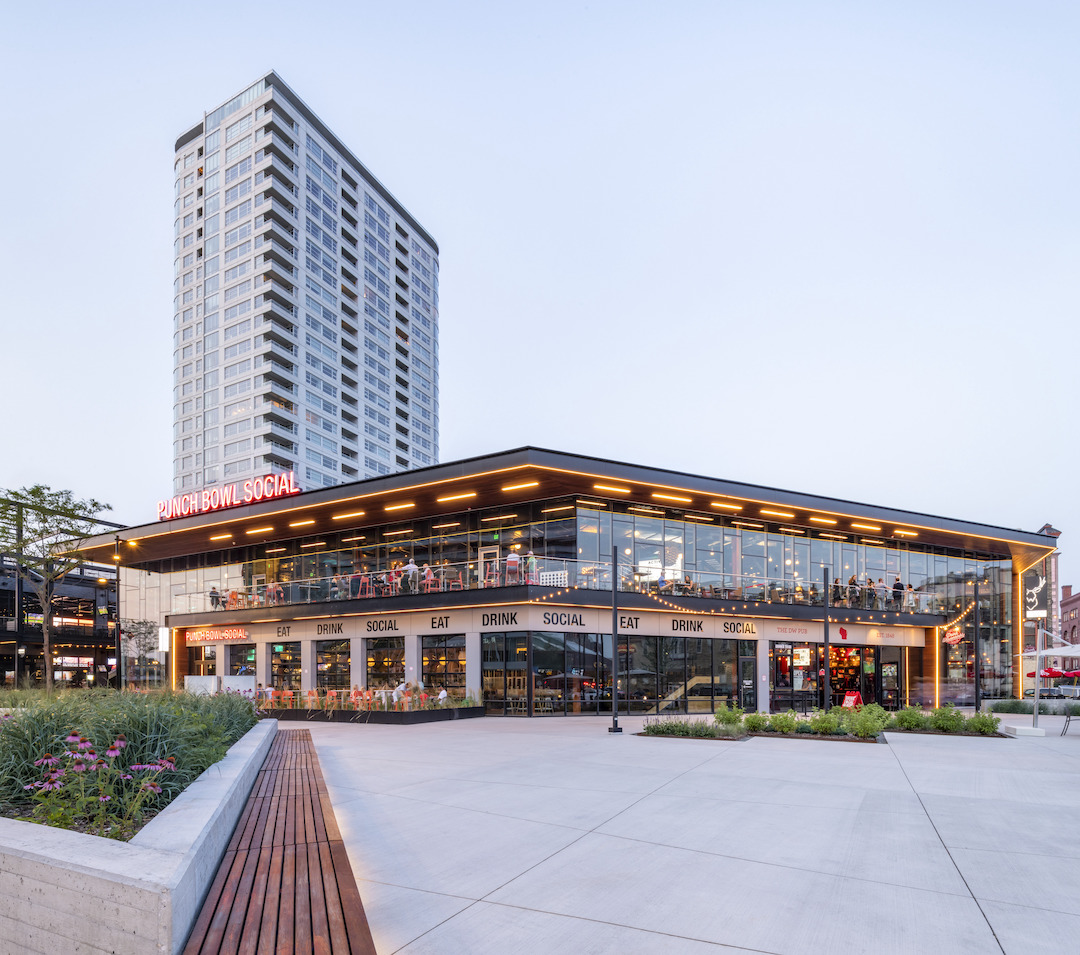
© Richard Ebbers, Design by Gensler in partnership with RINKA
Additionally, what may work in Milwaukee won’t necessarily work in Los Angeles, Chicago, Miami, or Dallas. In the same way the architecture of the Fiserv Forum’s entertainment district is meant as an homage to the city’s industrial heritage, entertainment districts that surround other stadiums in other parts of the country need to do the same to embed themselves within the local culture and demographics.
Many of the people who will go to gather outside of the stadium may not follow the sport on a game by game basis. They simply want to be a part of an exciting moment sweeping through a given city, such as the case with Milwaukee’s championship run. This means the districts need to include elements that can help people socialize and be entertained in different ways. Access to restrooms and food/beverage offerings as well as a variety of seating and standing room areas are a critical factor for a successful entertainment district.
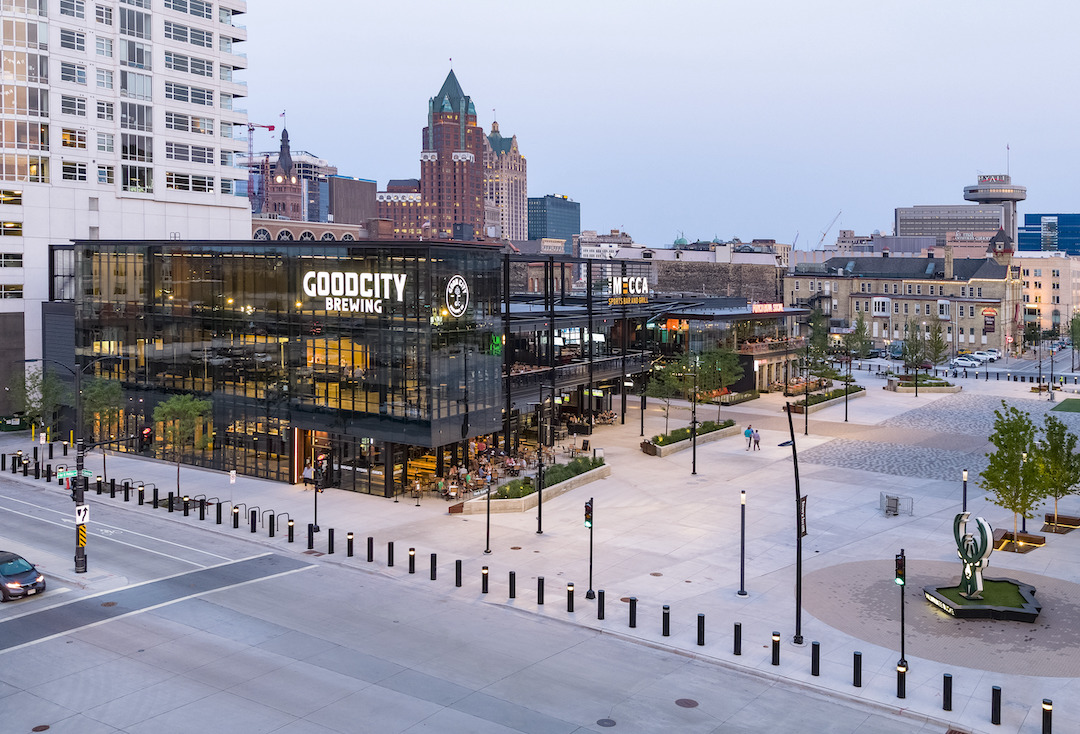
© Richard Ebbers, Design by Gensler in partnership with RINKA
Therein lies the key; a successful entertainment district needs to be a place people want to go to spend an afternoon or night when a team is good, bad, or playing elsewhere. Whether it is large crowds or small groups, people and the experiences they desire must come first.
“As humans, we crave being together,” said Sickman. “We want experiences where we can be with other people, where we can celebrate together, where we can sing, chant, drink, dance together. That’s the whole point of these districts, to bring people together.”
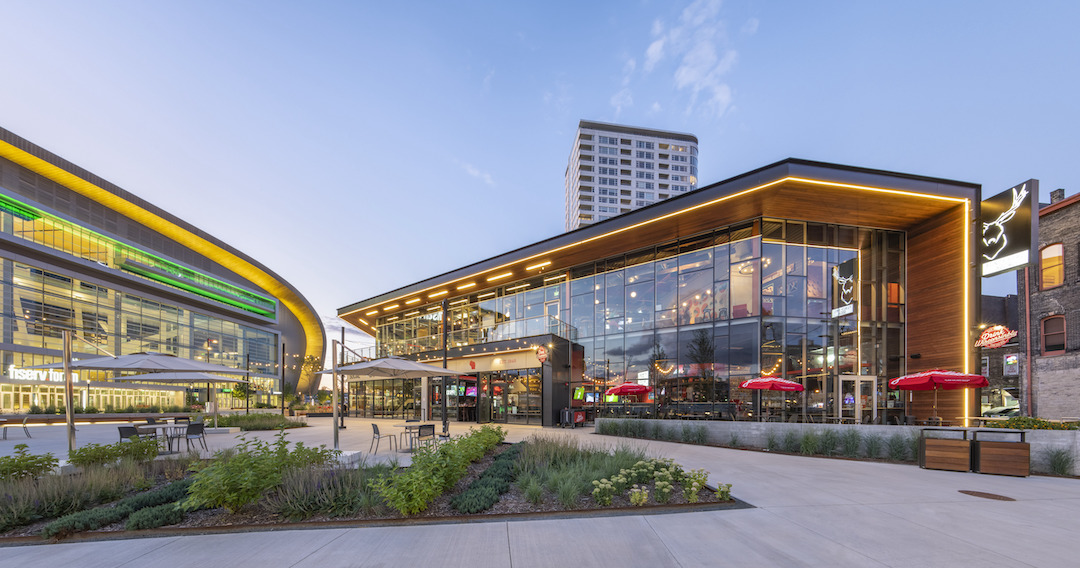
© Richard Ebbers, Design by Gensler in partnership with RINKA
Related Stories
| Aug 11, 2010
AASHE releases annual review of sustainability in higher education
The Association for the Advancement of Sustainability in Higher Education (AASHE) has announced the release of AASHE Digest 2008, which documents the continued rapid growth of campus sustainability in the U.S. and Canada. The 356-page report, available as a free download on the AASHE website, includes over 1,350 stories that appeared in the weekly AASHE Bulletin last year.
| Aug 11, 2010
Burt Hill, HOK top BD+C's ranking of the nation's 100 largest university design firms
A ranking of the Top 100 University Design Firms based on Building Design+Construction's 2009 Giants 300 survey. For more Giants 300 rankings, visit http://www.BDCnetwork.com/Giants
| Aug 11, 2010
PBK, DLR Group among nation's largest K-12 school design firms, according to BD+C's Giants 300 report
A ranking of the Top 75 K-12 School Design Firms based on Building Design+Construction's 2009 Giants 300 survey. For more Giants 300 rankings, visit http://www.BDCnetwork.com/Giants
| Aug 11, 2010
AGC unveils comprehensive plan to revive the construction industry
The Associated General Contractors of America unveiled a new plan today designed to revive the nation’s construction industry. The plan, “Build Now for the Future: A Blueprint for Economic Growth,” is designed to reverse predictions that construction activity will continue to shrink through 2010, crippling broader economic growth.
| Aug 11, 2010
Section Eight Design wins 2009 Open Architecture Challenge for classroom design
Victor, Idaho-based Section Eight Design beat out seven other finalists to win the 2009 Open Architecture Challenge: Classroom, spearheaded by the Open Architecture Network. Section Eight partnered with Teton Valley Community School (TVCS) in Victor to design the classroom of the future. Currently based out of a remodeled house, students at Teton Valley Community School are now one step closer to getting a real classroom.
| Aug 11, 2010
PCL Construction, HITT Contracting among nation's largest commercial building contractors, according to BD+C's Giants 300 report
A ranking of the Top 50 Commercial Contractors based on Building Design+Construction's 2009 Giants 300 survey. For more Giants 300 rankings, visit http://www.BDCnetwork.com/Giants
| Aug 11, 2010
Webcor, Hunt Construction lead the way in mixed-use construction, according to BD+C's Giants 300 report
A ranking of the Top 30 Mixed-Use Contractors based on Building Design+Construction's 2009 Giants 300 survey. For more Giants 300 rankings, visit http://www.BDCnetwork.com/Giants
| Aug 11, 2010
Report: Fraud levels fall for construction industry, but companies still losing $6.4 million on average
The global construction, engineering and infrastructure industry saw a significant decline in fraud activity with companies losing an average of $6.4 million over the last three years, according to the latest edition of the Kroll Annual Global Fraud Report, released today at the Association of Corporate Counsel’s 2009 Annual Meeting in Boston. This new figure represents less than half of last year’s amount of $14.2 million.


